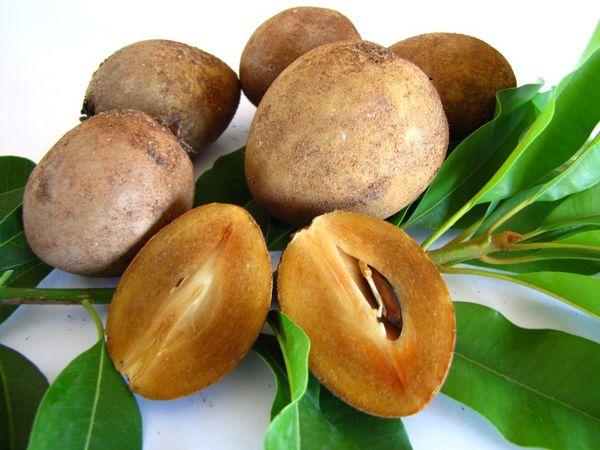
La sapodilla o sapote, also known as the Chewing-gum tree, thechewing gum tree, is an evergreen of the Sapotacae family, native to tropical America, specifically Yucatàn, where it grows wild.
It is a plant, but also its fruit, which is cultivated and grown in many varieties around the world, now also in India - where it is known as chikoo - in Australia, California, Indonesia and Florida.
As they deteriorate very quickly, the fruits are hardly exported: this is why they are not so well known in Europe. Central America and southern Mexico, on the other hand, have always exported considerable quantities of his whitish latex, especially to the United States, for the production of chewing gum, now replaced by synthetic ingredients.
Properties and benefits of the sapote
The yellowish-white pulp of its round fruits, 4-8 cm in diameter and greenish-brown in color, has a delicious flavor, reminiscent of a cross between pear and cane sugar, but also apricot and honey.
The heart of the fruit contains 3 to 12 black seeds. The peel and seeds are not edible. Sapodilla contains a lot of vitamin C, vitamin A, calcium and fiber. One fruit, which weighs around 170 grams, contains around 140 calories, nearly 80% water, fiber, carbohydrates, one gram of protein and low in fat.
It is a fruit easily digestible, which contains simple sugars that give the body energy and vitality: for this reason it lends itself to being perfect for those who practice physical activity and for sportsmen.
In addition to having, as seen, good doses of vitamins, it is also rich in minerals (potassium, copper, iron) and tannins that give it antioxidant and anti-inflammatory properties. Thanks to the fibers it is great natural laxative.
Here are a couple of recipes, one sweet and one savory.
For constipation, also try laxative herbal teas
Sapodilla Pie
Ingredients:
> 1 cup of sugar;
> half a teaspoon of salt;
> 1 tablespoon of chopped cloves;
> 3 eggs;
> 2 cups of sapodilla pulp, ripe and crushed;
> 1 cup of milk;
> 1 cup of yoghurt;
> 3 tablespoons of honey;
> 1 teaspoon of vanilla powder;
Bring a large size to cook it
Preparation: preheat the oven to 180 °. Mix the sugar, salt and cloves in a small bowl, beat the eggs in a large bowl, then add the sapodilla pulp and the sugar and clove mix. Gradually add, always stirring, the milk, yoghurt, honey and vanilla.
Pour into the pan previously lined with baking paper. Cook for 15 minutes, lower the temperature to 120 ° and cook for another half hour. Serve warm, with whipped cream if desired.
Tropical sapodilla rice
Ingredients for people 4:> 3 cups of basmati or Thai rice;> 2 ripe sapodils cut into small squares;> a couple of tablespoons of lime or lemon peel cut into very thin slices;> 2 tablespoons of fresh ginger cut into small pieces;> oil.
Preparation: boil the rice with a little salt, in a pan sauté the sapodilla with olive or seed oil, sauté the pieces of fruit, lime or lemon and ginger together for a few minutes and add the rice. Serve piping hot.
In tropical kitchens it is also consumed as an addition to salads or desserts, such as ice cream and sorbets. In Malaysia, futto is stewed with lime or comes fried with ginger. In India it is often eaten dried.
Please note:: the sapodilla is eaten only when it is ripe, unripe is not good, it "binds" in the mouth!
Also discover the properties of feijoa and amolo, forgotten fruits


























